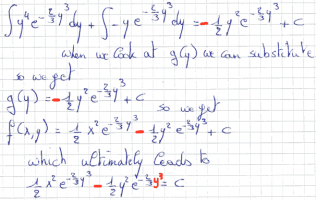Hi,
I need to solve this equation. I am following the book Ordinary differential equations with applications from Andrews.
It is this : xdx-ydy=y^2(x^2-y^2)dy
I found the integrating factor which was e^((-2/3)y^3)
With that I found the function f(x,y)=(1/2)x^2e^((-2/3)y^3)+g(y)
Now I need to find g(y)
with that I got integral of y^4e^((-2/3)y^3)-ye^((-2/3)y^3
But I just don't know how to solve that.
In an integral calculator I get an incomplete gamma function (never seen that).
And in the back of the book the solution is stated as (1/2)ln(x^2-y^2)=(1/3)y^3+C
Could anyone help me?
I need to solve this equation. I am following the book Ordinary differential equations with applications from Andrews.
It is this : xdx-ydy=y^2(x^2-y^2)dy
I found the integrating factor which was e^((-2/3)y^3)
With that I found the function f(x,y)=(1/2)x^2e^((-2/3)y^3)+g(y)
Now I need to find g(y)
with that I got integral of y^4e^((-2/3)y^3)-ye^((-2/3)y^3
But I just don't know how to solve that.
In an integral calculator I get an incomplete gamma function (never seen that).
And in the back of the book the solution is stated as (1/2)ln(x^2-y^2)=(1/3)y^3+C
Could anyone help me?




